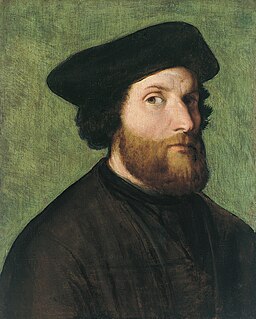
Lorenzo Lotto was an Italian painter, draughtsman and illustrator, traditionally placed in the Venetian school, though much of his career was spent in other north Italian cities. He painted mainly altarpieces, religious subjects and portraits. He was active during the High Renaissance and the first half of the Mannerist period, but his work maintained a generally similar High Renaissance style throughout his career, although his nervous and eccentric posings and distortions represented a transitional stage to the Florentine and Roman Mannerists.

The Galleria Borghese is an art gallery in Rome, Italy, housed in the former Villa Borghese Pinciana. At the outset, the gallery building was integrated with its gardens, but nowadays the Villa Borghese gardens are considered a separate tourist attraction. The Galleria Borghese houses a substantial part of the Borghese collection of paintings, sculpture and antiquities, begun by Cardinal Scipione Borghese, the nephew of Pope Paul V. The Villa was built by the architect Flaminio Ponzio, developing sketches by Scipione Borghese himself, who used it as a villa suburbana, a country villa at the edge of Rome.

David with the Head of Goliath is a painting by the Italian Baroque artist Caravaggio. It is housed in the Galleria Borghese, Rome. The painting, which was in the collection of Cardinal Scipione Borghese in 1650, has been dated as early as 1605 and as late as 1609–1610, with more recent scholars tending towards the former.

Girolamo Savoldo, also called Girolamo da Brescia was an Italian High Renaissance painter active mostly in Venice, although he also worked in other cities in northern Italy. He is noted for his subtle use of color and chiaroscuro, and the sober realism of his works, which are mostly religious subjects, with a few portraits, which are given interest by their accessories or settings, "some even look like extracts from larger narratives".

David with the Head of Goliath, c. 1607, in the Kunsthistorisches Museum Gemäldegalerie, Vienna, is a painting by the Italian artist Caravaggio (1571–1610). Peter Robb believes it to have been acquired by the conde de Villamediana in Naples between 1611 and 1617, as Giovanni Bellori records Villamediana as having returned to Spain with a half-figure of David by Caravaggio.

The Palazzo Pallavicini-Rospigliosi is a palace in Rome, Italy. It was built by the Borghese family on the Quirinal Hill; its footprint occupies the site where the ruins of the baths of Constantine stood, whose remains still are part of the basement of the main building, the Casino dell'Aurora. Its first inhabitant was the famed art collector Cardinal Scipione Borghese, the nephew of Pope Paul V, who wanted to be housed near the large papal Palazzo Quirinale. The palace and garden of the Pallavicini-Rospigliosi were the product of the accumulated sites and were designed by Giovanni Vasanzio and Carlo Maderno in 1611–16. Scipione owned this site for less than a decade, 1610–16, and commissioned the construction and decoration of the casino and pergolata, facing the garden of Montecavallo. The Roman palace of this name should not be mistaken for the panoramic Villa Pallavicino on the shores of Lake Como in Lombardy.
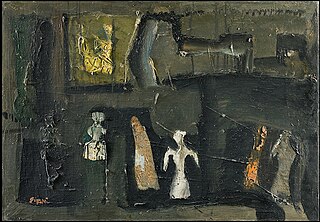
Mario Sironi was an Italian modernist artist who was active as a painter, sculptor, illustrator, and designer. His typically somber paintings are characterized by massive, immobile forms.

The Borghese Collection is a collection of Roman sculptures, old masters and modern art collected by the Roman Borghese family, especially Cardinal Scipione Borghese, from the 17th century on. It includes major collections of Caravaggio, Raphael, and Titian, and of ancient Roman art. Cardinal Scipione Borghese also bought widely from leading painters and sculptors of his time, and Scipione Borghese's commissions include two portrait busts by Gian Lorenzo Bernini. Most of the collection remains intact and on display at the Galleria Borghese, although a significant sale of classical sculpture was made under duress to the Louvre in 1807.

Portrait of Young Woman with Unicorn is a painting by Raphael, which art historians date c. 1505-1506. It is in the Galleria Borghese in Rome. The painting was originally oil on panel, and was transferred to canvas during conservation work in 1934. It was in the course of this work that overpainting was removed, revealing the unicorn, and removing the wheel, cloak, and palm frond that had been added by an unknown painter during the mid-17th century.
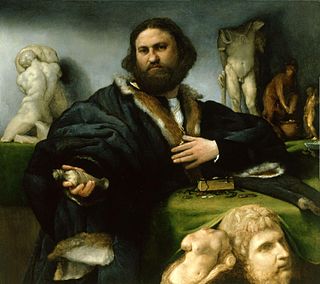
The Portrait of Andrea Odoni is a painting by the Italian High Renaissance painter Lorenzo Lotto dated 1527, now in the Royal Collection of the United Kingdom. In early 2019 it was on loan to the National Gallery for an exhibition of Lotto's portraits.

Christ among the Doctors is an oil painting by Albrecht Dürer, dating to 1506, now in the Museo Thyssen-Bornemisza, Madrid, Spain. The work dates to Dürer's sojourn in Venice, and was executed hastily while he was working at the Feast of the Rosary altarpiece.
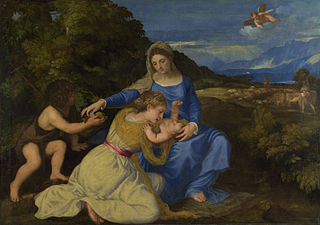
The Madonna of the Rabbit, The Aldobrandini Madonna, The Virgin and Child with the Infant Saint John and a Female Saint or Donor or The Virgin and Child with the Infant Saint John and Saint Catherine is an oil on canvas painting by Titian dating to around 1530 and now held in the National Gallery in London. There are studio copies in the Galleria Palatina in Florence and in the Kunsthistorisches Museum in Vienna.

Healing of the Man Born Blind is a c.1573 painting by El Greco, showing the healing the man blind from birth. It is now in the Galleria nazionale di Parma. It is signed at the bottom right-hand corner. It shows the artist returning to a theme he had first painted five years earlier, in a work now in Dresden.

Portrait of a Young Man or Portrait of a Gentleman in his Study is a painting by Lorenzo Lotto, created c. 1530, now in the Gallerie dell'Accademia of Venice, whose collections it entered from a private collection in 1930. It is known in Italian as Giovane malato, literally The Ill Young Man - the flower with leaves is thought to be a symbol of disappointment in love or an illness, perhaps melancholy. The subject also turns his back on worldly pleasures. More so than in other works produced around the same time by the artist such as his Portrait of Andrea Odoni, it shows Lotto moving beyond the influence of Titian with preciser definition of details and contours.
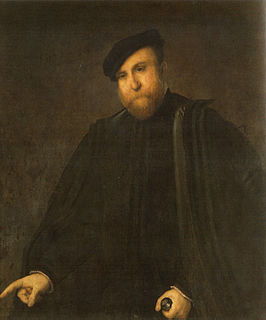
Portrait of a Man is an oil on canvas painting by Lorenzo Lotto, dated to around 1545 due to its stylistic similarities to the artist's other works in the mid-1540s such as Portrait of an Old Man with Gloves (Milan). Another theory holds that the subject is Giovanni Taurini da Montepulciano, viceroy of Ancona, which would change the date to 1551, the year of Lotto's arrival in Ancona. It is now in the Pinacoteca di Brera in Milan, which it entered in 1855 as part of the Oggioni Bequest.

Portrait of an Old Man with Gloves is an oil on canvas painting by Lorenzo Lotto, signed "L. Loto" and dated to around 1543 due to stylistic similarities with Portrait of Febo da Brescia, Portrait of a Thirty-Seven-Year-Old Gentleman and other works produced by the artist in the mid 1540s. Its final private owner was count Castellane Harrach of Turin, from whose collection it entered the Pinacoteca di Brera in Milan in 1859, where it still hangs.
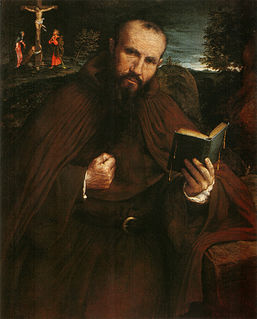
Portrait of Brother Gregorio Belo of Vicenza is a 1547 oil on canvas painting by Lorenzo Lotto, now in the Metropolitan Museum of Art in New York. It is inscribed bottom right "F. Gregorr belo de Vicentia / eremite in Hieronimi Ordinis beati / fratri Petris de Pisis Anno / etatis eius LV, M.D.XLVII". Its subject was a Hieronymite monk and so the image's iconography draws on that of the penitent St Jerome.

Portrait of a Woman Inspired by Lucretia is an oil on canvas portrait by Lorenzo Lotto, created c. 1533. It is now in the National Gallery, London, which bought it in 1927.

Saint Anthony Preaching to the Fish is a 1580–1585 oil on canvas painting of Anthony of Padua by Paolo Veronese, now in the Galleria Borghese in Rome. Its original location is unknown, though its medium dimensions of 104 centimetres (41 in) by 150 centimetres (59 in) mean it may have been painted for the side wall of a chapel or as part of a cycle of paintings for a small school (scuola) somewhere in Veneto. It entered the collection of Cardinal Scipione Borghese as a 1607 gift from Francesco Barbaro.

The Concert or The Interrupted Concert is a c.1543–1564 oil on canvas painting by Titian, now in the Galleria Palatina in Florence. A copy in the Galleria Borghese includes an additional fourth figure.




















